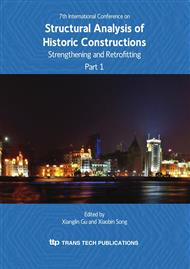p.789
p.795
p.801
p.807
p.815
p.821
p.831
p.837
p.843
Safety Risk Management in the Reformation of Bracket Girder and Cut Column for an Existing Industrial Single-Storey Building
Abstract:
The adaptability is important in the technological reformation of industrial building. Bracket girder and cut column (BGCC), are widely used to expand the space and to increase the inner working room of the buildings. Reformation of the exiting industrial building is limited to the continuous and non-stop working and (must be) in service and the reformation is required to be non-stop. Industrial buildings, especially the industrial single-storey workshops mostly belong to static determinate and low-order static indeterminate structures and many risks may be faced during the BGCC reformation under the complicated working conditions, such as variable structure risk, structural failure caused by overload, injuries of workers resulted from the unsafe construction, injuries of the production workers due to construction operation, etc. Research on the safety risk management of the industrial building BGCC reformation is of great significance for ensuring the technological transformation of industrial enterprises and controlling the risks from the reformation of adaptability of industrial buildings in China. Consequently, based on the approaches of risk identifying on work decomposition structure(WBS) and the questionnaire, the whole process design and construction management methods are proposed to control the risks in the reformation of the exiting industrial buildings, and the total management of construction process can be used to reduce injury risks of engineering staffs. In this paper, the technological key points of the whole process design control and construction management are discussed in details based on examples of BGCC reformation of exiting industrial single-storey buildings and the corresponding injury risk management methods are suggested.
Info:
Periodical:
Pages:
815-820
Citation:
Online since:
October 2010
Authors:
Price:
Сopyright:
© 2010 Trans Tech Publications Ltd. All Rights Reserved
Share:
Citation:


